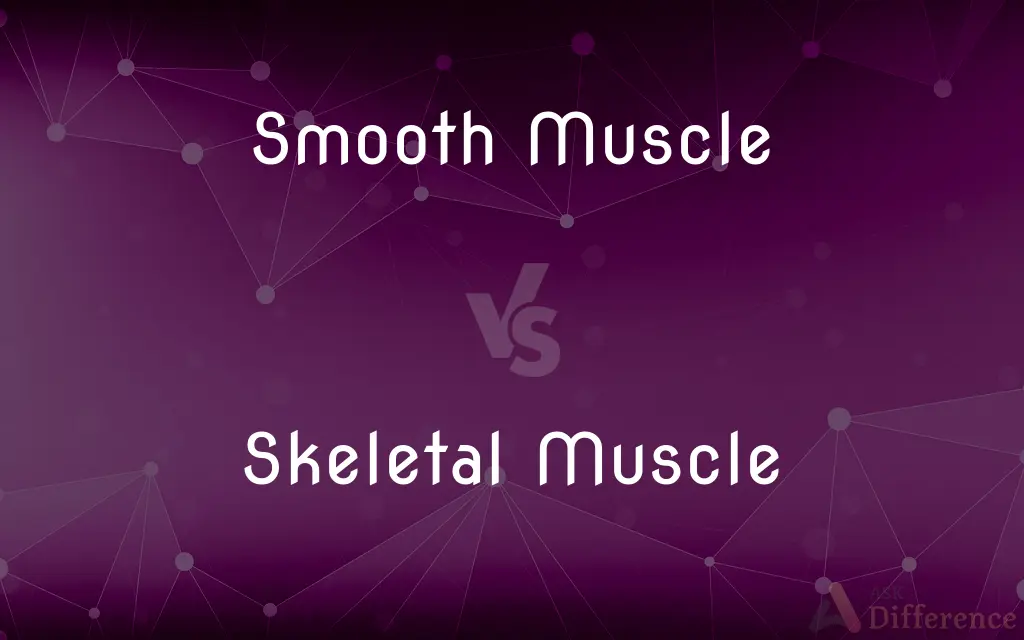Smooth Muscle vs. Skeletal Muscle — What's the Difference?
Edited by Tayyaba Rehman — By Fiza Rafique — Published on November 29, 2023
Smooth Muscle is involuntary, non-striated muscle found in organs; Skeletal Muscle is voluntary, striated muscle attached to bones.

Difference Between Smooth Muscle and Skeletal Muscle
Table of Contents
ADVERTISEMENT
Key Differences
Smooth Muscle is responsible for involuntary movements within the body, predominantly within organs like the stomach, intestines, and blood vessels. On the contrary, Skeletal Muscle is directly tied to our voluntary actions, allowing us to move our bones and perform physical activities.
Unlike Smooth Muscle, which has a uniform appearance under a microscope due to its non-striated nature, Skeletal Muscle exhibits a striped, or striated, pattern. This striation in Skeletal Muscle arises from its organized structure, with repeating units called sarcomeres.
Smooth Muscle lacks the distinct banding pattern seen in Skeletal Muscle and functions at a slower pace, allowing for functions such as the slow contractions of the intestines. In contrast, Skeletal Muscle offers quicker, more forceful contractions, ideal for rapid and powerful bodily movements.
Both Smooth Muscle and Skeletal Muscle play critical roles in our physiology. While Smooth Muscle ensures the internal processes like digestion and blood flow continue without our conscious effort, Skeletal Muscle gives us the capability to interact with our environment, move, and express physically.
One unique characteristic of Smooth Muscle is its ability to remain contracted for extended periods without tiring, like in the walls of blood vessels. Conversely, Skeletal Muscle, while powerful, tires more quickly, requiring periods of rest after strenuous activity.
ADVERTISEMENT
Comparison Chart
Control
Involuntary
Voluntary
Appearance
Non-striated
Striated
Location
Organs, blood vessels, etc.
Attached to bones
Contraction Speed
Generally slower
Faster, more forceful
Fatigue Resistance
Can sustain contractions longer
Tires more quickly
Compare with Definitions
Smooth Muscle
Essential for many internal processes.
The functioning of our respiratory system relies on Smooth Muscle contractions.
Skeletal Muscle
Voluntary muscles attached to bones.
Flexing the arm involves the contraction of Skeletal Muscle.
Smooth Muscle
Involuntary muscles found in organs.
The Smooth Muscle in the intestines helps push food through the digestive tract.
Skeletal Muscle
Enables movement and physical activity.
Jumping and running are made possible by Skeletal Muscle contractions.
Smooth Muscle
Controls slow, sustained contractions.
Blood vessels contain Smooth Muscle, allowing them to constrict or dilate.
Skeletal Muscle
Contains repeating units called sarcomeres.
The banding pattern in Skeletal Muscle arises from its organized sarcomeres.
Smooth Muscle
Can remain contracted for long durations.
The constant tone of Smooth Muscle in arteries helps maintain blood pressure.
Skeletal Muscle
Tires more quickly than Smooth Muscle.
After lifting heavy weights, your Skeletal Muscle might require rest.
Smooth Muscle
Non-striated muscle tissue.
Under a microscope, Smooth Muscle lacks the banding seen in Skeletal Muscle.
Skeletal Muscle
Striated muscle tissue.
The striations in Skeletal Muscle are evident when viewed under a microscope.
Common Curiosities
What's the primary difference between Smooth and Skeletal Muscle?
Smooth Muscle is involuntary and non-striated; Skeletal Muscle is voluntary and striated.
Can we control our Skeletal Muscles?
Yes, Skeletal Muscle is responsible for voluntary movements.
Where is Smooth Muscle located?
It's predominantly found in organs, blood vessels, and the respiratory tract.
Which muscle maintains our posture?
Skeletal Muscle plays a key role in maintaining posture.
Can we grow more Skeletal Muscle with exercise?
Exercise can increase Skeletal Muscle size, but not the number of muscle cells.
What gives Skeletal Muscle its striped appearance?
Its striations result from organized sarcomeres within the muscle fibers.
Why is it called "Smooth" Muscle?
It appears uniform and non-striated under a microscope.
Do both muscle types contract at the same speed?
No, Skeletal Muscle contracts faster, while Smooth Muscle contracts slower.
Why don't we feel tired when our intestines move?
Smooth Muscle can sustain contractions without quickly tiring.
Can Skeletal Muscle contract without conscious effort?
Typically no, but reflex actions are exceptions.
Do both muscles regenerate at the same rate?
Skeletal Muscle can regenerate to some extent, but Smooth Muscle regeneration is limited.
Why is Skeletal Muscle important for body temperature?
Skeletal Muscle contractions produce heat, helping to maintain body temperature.
Which muscle type can lift heavier weights?
Skeletal Muscle, due to its rapid, forceful contractions.
Is the heart's muscle similar to Smooth or Skeletal Muscle?
Neither. The heart's muscle is called cardiac muscle, a third type.
How do Smooth Muscles respond to external stimuli?
They react involuntarily to hormonal or neural stimuli.
Share Your Discovery

Previous Comparison
Aspirin vs. Salicylic Acid
Next Comparison
Neuropeptides vs. NeurotransmittersAuthor Spotlight
Written by
Fiza RafiqueFiza Rafique is a skilled content writer at AskDifference.com, where she meticulously refines and enhances written pieces. Drawing from her vast editorial expertise, Fiza ensures clarity, accuracy, and precision in every article. Passionate about language, she continually seeks to elevate the quality of content for readers worldwide.
Edited by
Tayyaba RehmanTayyaba Rehman is a distinguished writer, currently serving as a primary contributor to askdifference.com. As a researcher in semantics and etymology, Tayyaba's passion for the complexity of languages and their distinctions has found a perfect home on the platform. Tayyaba delves into the intricacies of language, distinguishing between commonly confused words and phrases, thereby providing clarity for readers worldwide.
















































